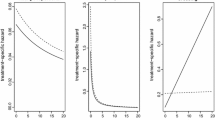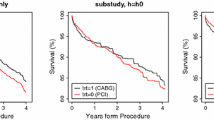Abstract
In this paper, the estimation of the difference between two median survival times is considered when two treatment groups of right-censored data and the associated covariates are available. To identify the possible range of covariates over which the two treatments would produce different median survival times, two confidence bands for the difference as a function of the covariates are proposed under the stratified and treatment-specific Cox models, respectively. The results of a simulation study indicate that the latter generally maintains its confidence level and the former holds its confidence level and preserves a narrower width when the two treatments satisfy the stratified Cox model. An application of the proposed confidence bands is finally illustrated with a data set in a two-arm lung cancer study.





Similar content being viewed by others
References
Andersen PK, Borgan Ø, Gill RD, Keiding N (1993) Statistical models based on counting processes. Springer, New York
Billingsley P (1999) Convergence of probability measures. Wiley, New York
Breslow NE (1972) Contribution to the discussion of “regression models and life tables” by D. R. Cox. J R Stat Soc B 34:216–217
Breslow NE (1974) Covariance analysis of censored survival data. Biometrics 30:89–100
Brookmeyer R, Crowley J (1982) A confidence interval for the median survival time. Biometrics 38:29–41
Burr D, Doss H (1993) Confidence bands for the median survival time as a function of the covariates in the Cox model. J Am Stat Assoc 88:1330–1340
Chen YI, Chang YM (2007) Covariates-dependent confidence intervals for the difference or ratio of two median survival times. Stat Med 26:2203–2213
Cox DR (1972) Regression models and life tables (with discussion). J R Stat Soc B 34:187–220
Doss H, Gill RD (1992) An elementary approach to weak convergence for quantile process, with applications to censored survival data. J Am Stat Assoc 87:869–877
Grambsch P, Therneau T (1994) Proportional hazards tests and diagnostics based on weighted residuals. Biometrika 81:515–526
Kalbfleisch JD, Prentice RL (2002) The statistical analysis of failure time data, 2nd edn. Wiley, New York
Kaplan EL, Meier P (1958) Nonparametric estimation from incomplete observations. J Am Stat Assoc 53:457–481
Klein JP, Moeschberger ML (2003) Survival analysis: techniques for censored and truncated data, 2nd edn. Springer, New York
Ramlau-Hansen H (1983) Smoothing counting process intensities by mean of kernel functions. Ann Stat 11:453–466
Su JQ, Wei LJ (1993) Nonparametric estimation for the difference or ratio of median failure times. Biometrics 49:603–607
Wang JL, Hettmansperger TP (1990) Two-sample inference for median survival times based on one-sample procedures for censored survival data. J Am Stat Assoc 85:529–536
Wei G, Schaubel DE (2008) Estimating cumulative treatment effects in the presence of nonproportional hazards. Biometrics 64:724–732
Ying Z, Jung SH, Wei LJ (1995) Survival analysis with median regression models. J Am Stat Assoc 90:178–184
Zucker DM (1998) Restricted mean life with covariates: modification and extension of a useful survival analysis method. J Am Stat Assoc 93:702–709
Acknowledgments
This research is supported in part by the National Science Council of Taiwan under Grant 95-2118-M-008-007-MY2.
Author information
Authors and Affiliations
Corresponding author
Appendix: Proof of Theorem 1
Appendix: Proof of Theorem 1
Let \(F_i (t)=1-\prod _{u\le t} {\{ {1-\Lambda _{0i} (du)} \}} \) and \(F_i (t|\mathbf{x})=1-\prod _{u\le t} {\{ {1-\Lambda _{0i} (du)} \}} ^{\exp ({\varvec{{\upbeta }}}^\prime \mathbf{x})}\) be the baseline distribution function and conditional distribution function, respectively, for subjects with covariates x in group \(i, i=0, 1\). The corresponding estimators under stratified Cox model (3) are then given by
and
The results of Theorem 3.2 and 3.4 in Andersen et al. (1993) imply that, for \(i=0, 1\), as \(n\rightarrow \infty \),
Since
by incorporating (A1)–(A3), we have
We then obtain, by using Theorem 1 in Doss and Gill (1992) along with the mean value theorem, that
where \(F^{d}\) is the derivative of \(F\),
and
After some algebraic manipulation, we have that, for \(i=0\), 1, as \(n\rightarrow \infty \),
where, for \(i=0, 1\),
with
Therefore, the continuous mapping theorem (Billingsley 1999) implies that
where
is a zero mean Gaussian process in \(C_q ({\varvec{{\mathfrak {X}}}})\). Since the variance of \(W_i \{a_{si} (\xi _i (\mathbf{x}))\}\) is \(a_{si} (\xi _i (\mathbf{x})), i= 0,1\), and the variance of \(\mathbf{Z}\) is an identity matrix, the variance function of \(U_s (\mathbf{x})\) is obtained as
Rights and permissions
About this article
Cite this article
Chen, YI., Chang, YM. & Lee, JY. Confidence bands for the difference between two median survival times as a function of covariates. Lifetime Data Anal 21, 97–118 (2015). https://doi.org/10.1007/s10985-013-9283-3
Received:
Accepted:
Published:
Issue Date:
DOI: https://doi.org/10.1007/s10985-013-9283-3




